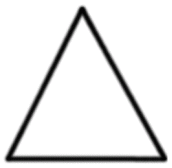Triangulation:
The Conciliatory Path to
Self-Knowing through Insight
by Art Ticknor
|
A friend reported an example of these glimpses where she saw or intuited that all things "have equal – something – weight or validity or whatever." (And she added, "Poor wording for something that went deep.") Now that may sound like nonsense – after all, some things are true while others are false, some bright while others are dark, pleasant versus unpleasant, and so on. Picturing a line, we can place things along the line according to how they compare in relationship to some set of opposites:
FALSE
How would we get a view, though, that shows us all things are equally valid in the sense of being true or false? It's like an incomprehensible report from a creature in 2-D space to a creature in 1-D space, as described so simply and brilliantly in Edwin Abbott's Flatland. From the higher perspective, the mind looks down on true-false as the base of a triangle as seen from its apex:
FALSE
If one is searching for absolute truth or validity, such a glimpse gives us an important clue. The mind gets a higher perspective by a conciliation of, or triangulation above, opposites. If one is searching for the ultimate validity of things, then the next triangulation might be over a baseline of things versus no thing. If one is searching for the ultimate self, conciliation of self versus other could lead to conciliation of oneness versus zeroness – the equivalent of things versus no thing, or of life versus death. The materialist is likely to believe that such triangulation is an endless process, whereas the idealist may believe otherwise. The intuitional mind admits the possibility of a final triangulation to Complete Validity – and its attainment as the ne plus ultra of existence.
The friend also wrote: "What I am is Awareness" is a phrase I frequently remind myself of, whenever I think of it – I don't need a refrigerator sticky for it, mind knows it is true, and I am only reminding myself that all that comfort and discomfort are in an unreal being, a projection as you call it, or a collection of memories as I would call it. That's good … also the clue as to where to find the umbilical cord that takes you home. From the mind's view there are two awarenesses … the one we're looking out from and the one that's conscious of the outward-looking one. Intuitively, though, you don't feel like two "things" or two different awarenesses, do you? But the mind sees two awarenesses within (plus the billions of other awarenesses outside). What's the truth? How can you triangulate over this awareness-looking-out and awareness-looking-back split? You've seen or intuited that all things have equal validity. "All things" can be split into endless camps of opposites: heavy things, light things; bright things, dark things; true things, false things, and so on. "All things" form the baseline of a triangle, with the description of opposites at either end. Triangulation refers to a view from the top point or apex of the triangle. "All conscious beings" could represent the baseline of a triangle. But it's difficult to conceive of what the view from the apex of that triangle might be (since you believe you're one of those conscious beings at the base). You could consider the opposite ends of the baseline to be "my consciousness" and "my son's consciousness," for example. Again it would be hard to conceive of the view that reconciles those opposites. When we come to that most relevant pair of opposites, "my outward-looking consciousness" and "my backward-looking consciousness," the triangulation or transcendence may happen when we see or intuit the self-aware nature of the outward-looking consciousness. If we see that the outward-looking consciousness is self-aware, where does that leave the belief in a separate self that's aware of it?
TAT Foundation Workshop Session Synopsis: To know the self, we need to go beyond relative knowing. To do so requires finding the conciliatory position beyond all opposites. The workshop includes exercises and discussion aimed toward that objective.
The mind tries to solve a problem by moving toward the opposite. But we ride the pendulum back and forth between too much and not enough. The solution occurs by seeming accident when we find ourselves observing at the still point from which the pendulum depends. That is the conciliatory position above the domain of opposition. The first such jump within the mind occurs when we get freed from the morass of identifying with emotions, which swing back and forth from positive to negative. When that occurs, we gradually become aware that we're on another pendulum, which swings back and forth between refereeing the continual war of desires and fears and feeling the intuitional messages coming into the mind, which Blavatsky termed the voice of silence. The conciliatory position above that pendulum swing is the point from which we can observe the workings of the mind with the mind. Beyond that, a "third eye" becomes conscious of awareness, and the mind gets caught in a loop of watching itself watching itself. This final opposition cannot be transcended in the mind. And if the mind continues this conscious tail-chasing to the point of surrender, we find ourselves back Home – viewing the mind from its source and knowing that we're beyond the limitations of manifestation, beyond life and death … and always have been.
In addition to Amazon.com, eBay.com and BookFinder.com are good sources of new and used books.
© 2000-2025. All rights reserved. | Back to Top |
 TRUE
TRUE